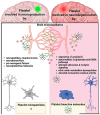Platelets, Protean Cells with All-Around Functions and Multifaceted Pharmacological Applications
- PMID: 36901997
- PMCID: PMC10002540
- DOI: 10.3390/ijms24054565
Platelets, Protean Cells with All-Around Functions and Multifaceted Pharmacological Applications
Abstract
Platelets, traditionally known for their roles in hemostasis and coagulation, are the most prevalent blood component after erythrocytes (150,000-400,000 platelets/μL in healthy humans). However, only 10,000 platelets/μL are needed for vessel wall repair and wound healing. Increased knowledge of the platelet's role in hemostasis has led to many advances in understanding that they are crucial mediators in many other physiological processes, such as innate and adaptive immunity. Due to their multiple functions, platelet dysfunction is involved not only in thrombosis, mediating myocardial infarction, stroke, and venous thromboembolism, but also in several other disorders, such as tumors, autoimmune diseases, and neurodegenerative diseases. On the other hand, thanks to their multiple functions, nowadays platelets are therapeutic targets in different pathologies, in addition to atherothrombotic diseases; they can be used as an innovative drug delivery system, and their derivatives, such as platelet lysates and platelet extracellular vesicles (pEVs), can be useful in regenerative medicine and many other fields. The protean role of platelets, from the name of Proteus, a Greek mythological divinity who could take on different shapes or aspects, is precisely the focus of this review.
Keywords: extracellular vesicles; inflammation; platelet derivatives; platelets.
Conflict of interest statement
The authors declare no conflict of interest.
Figures




Similar articles
-
Circulating Platelets as Mediators of Immunity, Inflammation, and Thrombosis.Circ Res. 2018 Jan 19;122(2):337-351. doi: 10.1161/CIRCRESAHA.117.310795. Circ Res. 2018. PMID: 29348254 Free PMC article. Review.
-
Platelets are versatile cells: New discoveries in hemostasis, thrombosis, immune responses, tumor metastasis and beyond.Crit Rev Clin Lab Sci. 2016 Dec;53(6):409-30. doi: 10.1080/10408363.2016.1200008. Epub 2016 Jul 22. Crit Rev Clin Lab Sci. 2016. PMID: 27282765 Review.
-
Role of platelets in hemostasis and thrombosis.West J Med. 1976 Sep;125(3):181-6. West J Med. 1976. PMID: 969503 Free PMC article.
-
Platelet physiology.Methods Mol Biol. 2013;992:13-30. doi: 10.1007/978-1-62703-339-8_2. Methods Mol Biol. 2013. PMID: 23546702
-
An Insight into Recent Advances on Platelet Function in Health and Disease.Int J Mol Sci. 2022 May 27;23(11):6022. doi: 10.3390/ijms23116022. Int J Mol Sci. 2022. PMID: 35682700 Free PMC article. Review.
Cited by
-
Progress in the application of novel inflammatory indicators in chronic kidney disease.Front Med (Lausanne). 2025 Jan 30;12:1500166. doi: 10.3389/fmed.2025.1500166. eCollection 2025. Front Med (Lausanne). 2025. PMID: 39950124 Free PMC article. Review.
-
Skin Telocytes Could Fundament the Cellular Mechanisms of Wound Healing in Platelet-Rich Plasma Administration.Cells. 2024 Aug 8;13(16):1321. doi: 10.3390/cells13161321. Cells. 2024. PMID: 39195210 Free PMC article. Review.
-
Platelet-Rich Plasma in Dermatology: New Insights on the Cellular Mechanism of Skin Repair and Regeneration.Life (Basel). 2023 Dec 25;14(1):40. doi: 10.3390/life14010040. Life (Basel). 2023. PMID: 38255655 Free PMC article. Review.
-
New role of platelets in schizophrenia: predicting drug response.Gen Psychiatr. 2024 Apr 9;37(2):e101347. doi: 10.1136/gpsych-2023-101347. eCollection 2024. Gen Psychiatr. 2024. PMID: 38616969 Free PMC article.
-
Photo-controlled co-delivery of verteporfin and acriflavine via platelets achieves potentiated glioblastoma-targeted photodynamic therapy.J Nanobiotechnology. 2025 May 22;23(1):371. doi: 10.1186/s12951-025-03395-x. J Nanobiotechnology. 2025. PMID: 40405165 Free PMC article.
References
-
- Rolla R., Puricelli C., Bertoni A., Boggio E., Gigliotti C.L., Chiocchetti A., Cappellano G., Dianzani U. Platelets: “multiple choice” effectors in the immune response and their implication in COVID-19 thromboinflammatory process. Int. J. Lab. Hematol. 2021;43:895–906. doi: 10.1111/ijlh.13516. - DOI - PMC - PubMed
-
- Diacovo T.G., Roth S.J., Buccola J.M., Bainton D.F., Springer T.A. Neutrophil Rolling, Arrest, and Transmigration Across Activated, Surface-Adherent Platelets Via Sequential Action of P-Selectin and the &-Integrin CDllb/CDl8. Blood. 1996;88:146–157. - PubMed
Publication types
MeSH terms
LinkOut - more resources
Full Text Sources
Medical

